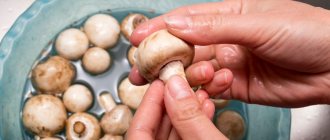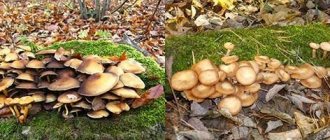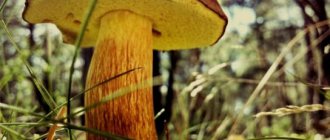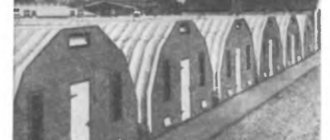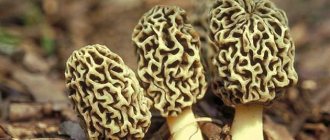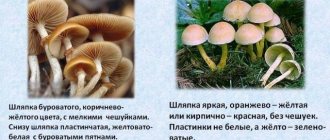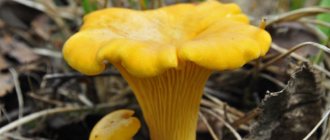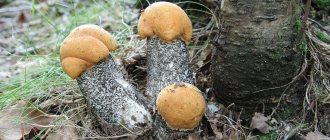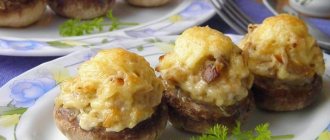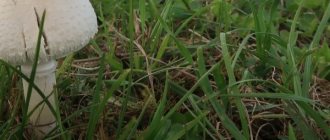Mushrooms
0
1712
Article rating
Kira Stoletova
Today, champignon mushrooms are on the shelves of almost all grocery stores in our country. This is the most popular species, which is collected not only in the wild, but also grown on mushroom farms, and some are able to harvest on their own balcony or windowsill.
Description of champignon mushrooms
General characteristics of champignons
It is difficult to confuse the common champignon, which is a saprotroph, with any other mushroom. Small mushrooms resemble small balls of white, beige or brownish color. Their hat is pressed tightly to the leg. As the pecheritsa (the second name of the mushroom) grows, the edges of the cap move away from the stem, and its shape becomes flat-rounded or flat. This type of mushroom is not large. The diameter of its cap varies between 5-10 cm. And only in certain varieties can the diameter of the cap exceed 10 cm. Pecheritsa weighs on average 20 g. But there are specimens weighing 30-35 g. Mini pecheritsa weigh 10-12 g. They bear fruit pecheritsy over a long period of time.
It is interesting that champignons do not form mycorrhizae, being exclusively saprophytes.
Fresh champignons are dense in structure. Their flesh is snow-white or white-yellow. Sometimes there is a pink tint. There must be a ring in the place where the leg meets the cap. It can consist of 1 or 2 layers and resembles a small skirt. This type of mushroom is popular because of its pronounced aroma, which adds a piquant taste to even a simple dish.
Habitat
The common champignon loves fertile soil and grows near manure heaps. It prefers mountainous terrain. It is often found in forests or steppes. Steppe species are less common than others. People have learned to grow large and tasty champignon mushrooms in their summer cottages. There are entire farms where pecheritsa are grown hydroponically.
Application in medicine
Mushroom juice is used for bactericidal effects against skin problems : ulcers, eczema, rashes, psoriasis, dermatitis. Dry champignon powder is used in the treatment of hepatitis and gastric ulcers. The diabetic table and salt-free diet include them in the diet to quickly lower glucose levels. For bronchial difficulties, champignon is used for an expectorant effect.
Thiamine and riboflavin, which are contained in this species, successfully fight migraines and headaches . Even with such dangerous diseases as tuberculosis, typhus, mumps, the use of fruiting bodies is recommended. According to recent studies, this mushroom has a positive effect on cells involved in the fight against cancer, strengthening the body's immune barrier.
Varieties of champignons
There are several classifications:
- Based on the presence of rings: two-ring and single-ring champignons are distinguished;
- By habitat:
- Forest soil saprophytes: forest champignon, sh. coppice.
- Soil saprophytes of open spaces devoid of plant cover: bisporus champignon, sh. double-ring, or sh. sidewalk, sh. half-shod.
- Herbophiles (only among grass): common champignon, sh. August.
- Growing in open spaces among grass and in forests: field champignon, sh. elegant.
- Desert (including halophiles): Bernard champignon.
Each type of champignon has slight external differences and a special taste. There are also differences in the structure and color of the pulp.
All of the above varieties are edible. But inedible and poisonous champignons are found in nature, which a mushroom picker must be able to distinguish from edible ones. There are also double mushrooms or false champignons, which are similar in description to ordinary champignons. If you look closely, it is easy to find characteristic differences.
Possible difficulties
Slow growth of mushrooms, the appearance of small non-developing specimens the size of an acorn, deformation of the fruiting bodies and red-brown flesh at the break may indicate the appearance of a viral disease of mummies. There are no treatments for this disease. In this case, part of the compost with the affected Champignons should be removed and the resulting depression should be covered with earth. As a preventive measure, you should pay more attention to the choice of compost and the quality of garden soil.
If the humidity of the compost differs greatly from the humidity of the cover garden soil, the so-called “floating mycelium” can form. Outwardly, it resembles white mold that forms on the top layer or white plates. To combat this phenomenon, you should improve ventilation, ensure more frequent moistening of the top layer, or add garden soil.
If “wormy” mushrooms appear, it means they were attacked by the larvae of gall gnats or fungus flies.
To get rid of them, before the next planting, you need to treat the substrate and top layer of soil with chlorophos. As a preventive measure, it is necessary to sterilize the compost and cover all entrance/ventilation openings of the room with insect nets. Editorial team LePlants.ru
Common types of champignons
The most common are real or ordinary champignons, forest, field, coppice, August and dark red.
Real champignon
Pecheritsa of this species are also called meadow pecherits. Their height is 5-7 cm. The maximum height of meadow pecheritsa is 10 cm. This variety belongs to large champignons, the diameter of the cap of which varies from 10 to 15 cm. In young pecheritsa, the cap has the shape of a hemisphere, and its edges adjacent to the stem are tightly wrapped inside. With age, their caps acquire an almost flat shape. The diameter of the stem does not exceed 2 cm. The flesh of this variety of pecheritsa is snow-white. At the cut site, the pulp oxidizes in air and acquires a delicate pinkish tint.
Forest pecheritsy
It is better to look for fresh champignons of this type in coniferous forests. Forest pecherits are much less common in deciduous forests. They grow several dozen copies together, uniting in large groups. The cap of this champignon, on which there are small scales, looks like an egg or a bell. As they grow, their caps become almost flat. The height of the leg does not exceed 6 cm.
There are small scales on the mushroom cap
Forest pecheritsa are painted light brown. The scales have a richer color than the main body of the mushroom. More often they are located closer to the center of the cap and less often - to its edges. Inside there is snow-white pulp. The cut area takes on a reddish tint.
Field pecheritsa
Champignons of the sidewalk, two-ring or field types grow both in the mountains and on the plains. Field pecheritsa cannot be seen in deciduous forests. The hat is initially shaped like a bell with the edges slightly curved inward. As the mushroom grows, the cap becomes flatter, but a small tubercle remains on the central part. The two-ringed champignon is painted white or cream. On the surface of the cap there are sometimes scales that have a silky structure and are colored white-yellow. With age, the cap changes color to ocher.
Field pecheritsa are valued for their dense and fleshy pulp and good taste. The taste of mushrooms contains anise notes. Cut pecheritsa acquire a yellowish tint.
The properties of field champignons are attractive, but this type of champignon must be collected carefully, because it has similarities to some poisonous mushroom species.
Copperwood pecheritsa
Fresh coppice champignons are valued for their aniseed aroma, which persists even after heat treatment. Copper or thin pecheritsa grow both in groups and individually. Young pecherits have caps that are shaped like eggs. Over time, they straighten and become flat-rounded or resemble the shape of an athletes throwing disc. The diameter of the caps of fresh champignons of this species usually does not exceed 10 cm.
The caps of young mushrooms are painted in a delicate cream color, which darkens over time, gradually acquiring a light brown tint. There are no scales on the caps, and the surface of the mushrooms is silky to the touch. The delicate body of the mushroom changes color when pressed, acquiring a yellow tint.
Dark red pecheritsa
This species lives near deciduous trees. It’s easy to guess the color of this type of champignon from their name. In young mushrooms, the caps are shaped like a cone with a cut off top, and under the cap the plates of a delicate structure turn pink. As they grow, they acquire a flat-oval shape.
Young spring brown mushrooms may have a smooth surface on their caps. Over time, cracks appear on it, in place of which scales form. The legs are painted gray, which harmonizes with the brown caps. The height of an adult mushroom does not exceed 10 cm.
The name of the mushroom is due to the fact that the snow-white pulp at the cut site instantly turns red and an unusual smell appears.
Augustov Pecheritsy
These champignons with a white stem and a light brown cap are demanding in terms of environmental conditions. They grow only in temperate regions. August pecheritsa grow next to coniferous and deciduous trees, and occasionally they are found in park areas. Small August mushrooms have a cap that resembles a ball, which straightens and becomes flat and round as it grows. This variety of pecheritsa usually grows in colonies. They are often found near large anthills.
Fresh August champignons have a huge number of small scales on their caps, which are brick-colored. The color of the cap itself is brown. The leg is painted white. These are large organisms: the diameter of the cap varies from 13 to 15 cm. In cooking, this type of mushroom is valued for its characteristic almond aroma, which is revealed during heat treatment.
If you cut the mushroom, the flesh will darken or acquire a yellowish tint. These pecheritsa ripen at the end of summer. The fruiting period is 3 months.
Places of growth
You need to look for champignons at a certain time. The optimal period for collecting them is the end of May (beginning of fruiting) and the end of September.
Pecheritsa are very fond of areas where the soil is rich in humus (humus). To find them, you can safely go:
- meadows;
- pastures;
- parks;
- forest edges.
They can also often be found in gardens, near farms and on cultivated plots of land. Pecheritsa prefer open areas, and only occasionally hide in thickets of grass.
Doubles and false champignons
Champignons have many poisonous counterparts
Deadly mushrooms for humans, which are similar in external characteristics and structure to pecheritsa, are white fly agaric and pale toadstool. Most of all they look like coppice pecheritsa. It is easy to recognize poisonous mushrooms among edible ones by the shade of the pulp at the cut site. In poisonous mushrooms it does not oxidize and retains its original color. An adult edible mushroom changes the color of the plates located on the inside of the cap. In poisonous mushrooms it remains unchanged. The presence of a volva surrounding the swollen base of the leg of the pale toadstool or white fly agaric is another difference between poisonous mushrooms and pecheritsa, which do not have it.
Inedible varieties of pecheritsa are the rufous or yellow-skinned and flat-capped champignons. To determine that pecheritsa is inedible, an incision is made. The cut area turns bright yellow or orange, colors not typical of edible varieties. The mushroom also emits an odor that is similar to the smell of medicine (often called “pharmacy”). If you put an inedible fresh champignon in water, the smell will become more pronounced, and the body of the pepper will turn yellow. The water will also turn yellow. If you cook an edible mushroom, the water will change color slightly.
Irina Selyutina (Biologist):
For yellow-skinned champignon, or sh. The reddish one is characterized by the presence of a swelling at the base of the stem, which is not present in edible representatives of the Champignon genus. According to the degree of toxicity, this species is classified as moderately poisonous mushrooms. This means that if it is eaten, a rather serious disorder of the gastrointestinal tract may occur. Unfortunately, to date, the active substance of the yellow-skinned champignon has not been established. But, despite this, w. yellowskin is used in folk medicine due to the presence of natural antibiotics in its fruiting body.
For your information. When collecting wild champignons, the mushroom picker needs to be very careful, because Yellowing on the stem or cap of the yellow-skinned champignon does not appear immediately, but after some time.
The flat-headed champignon is another mushroom that belongs to the Champignon family and is poisonous. This is a lamellar mushroom with a scaly cap. It is distinguished from its edible brothers in the family by its sharp, unpleasant odor. Yellow champignon is also dangerous. It is distinguished by its large size (the diameter of the cap exceeds 15 cm). When cut, the yellowing mushroom becomes bright yellow. The poisonous champignon, which is called variegated, is rare.
Champignon is not a tubular mushroom, unlike some poisonous varieties. This feature is also used to distinguish edible species from inedible ones in the forest (there are more poisonous species among lamellar species than among tubular species).
Fresh or boiled false champignons contain the same amount of toxic substances that cause disruption of the gastrointestinal tract.
Interesting Facts
Starting from the 17th century, champignons began to be grown independently in underground premises. Italy is the first country to cultivate this type of mushroom. At that time, champignons were considered a delicacy that only monarchs could afford. These mushrooms appeared on our territory by the end of the 18th century. In the modern world, the cultivation of champignons is developed in many countries of Eurasia and North America. Their production annually is about a million tons.
This type of mushroom is also widely used in medicine and cosmetology. Champignons are useful for diabetes, hepatitis and even tuberculosis. Masks for problem skin are made from the oil extract of these mushrooms in beauty salons.
Useful properties of pecheritsa
Pecheritsa are rich in protein, so they can be a meat substitute for vegetarians or during fasting. In addition to protein, they contain amino acids necessary for the normal functioning of the body, minerals and carbohydrates. Pecheritsa are also popular among nutritionists. Their KBZHU indicators (calorie content, the ratio of proteins, fats and carbohydrates) are as follows: calorie content is only 270 kcal per kg of product, and the glycemic index is 15 units. With such a low calorie content, pecherits have a high energy value. Few foods on the calorie table are so low or have such significant energy value.
Fresh, boiled and baked products are low in calories. Dried pecheritsa contain 2-2.5 times more calories.
Pecheritsa are also record holders for the content of B vitamins. Medicine knows that they contain antioxidant properties and folic acid, which is necessary for women’s health. Pecheritsa are also rich in fiber and are useful for high cholesterol levels.
Irina Selyutina (Biologist):
In addition to the above, it is necessary to point out that champignons contain:
- a large amount of vitamin D2, which prevents the development of osteoporosis;
- the compound pyrocatechin (a phenolic compound with a characteristic phenolic odor), which has a hemostatic effect;
- Omega-6 fatty acid, which is an excellent preventative against atherosclerosis, improves bone nutrition and stops the development of many inflammatory processes.
By the way. A 2009 study on the occurrence and development of breast cancer, in which 2022 women took part, showed that the introduction of mushrooms into the diet stops the development of oncological processes. You can reduce the occurrence of breast cancer by 90% if you regularly eat champignons and green tea.
There is currently ongoing debate about the benefits of eating raw pecheritsa. Of course, a fresh product contains much more useful substances than one that has been heat-treated. But the organism, which was grown with insecticides, can easily be poisoned. It is better to heat-treat purchased products. The taste of heat-treated pecheritsa is much better.
When cooking mushrooms, cut them rather than cook them whole, this will help determine whether the organism is edible. And only then it can be boiled, fried or stewed. Poached mushrooms are delicious, i.e. fried over low heat in butter for 5-7 minutes. Cooking and stewing do not exceed 15 minutes.
Pecheritsa take a long time to digest, which is why you shouldn’t eat them at night.
Contraindications to the use of champignons
It is not advisable to eat mushrooms if you have a stomach ulcer.
If you have pancreatitis, gout and gastritis, you should refrain from eating pecheritsa. Mushrooms are also not recommended for stomach ulcers. If these diseases are not in the acute stage, then eating mushrooms in small quantities will not cause harm to the body. You should give preference to dishes that are cooked not in vegetable oil, but in water.
Any mushroom is an allergen, so it is recommended to consume them in moderate doses. And allergy sufferers should first find out whether they have an intolerance to the components of mushrooms. Pecheritsa are also contraindicated during lactation.
Their use is not contraindicated for diabetics. It does not matter what type of diabetes we are talking about. Pecheritsa are also used for cancer. If we talk about age restrictions, then mushrooms are not recommended for young children. It is better to introduce pecheritsa into the diet of children at the age of 4-6 years. This is due to the fact that chitin in mushrooms is poorly absorbed by the child’s body.
Evaluation of taste qualities, medicinal properties, benefits and possible harm
Sidewalk champignon is classified as a third category mushroom and is considered quite tasty and a delicacy. It can even be eaten raw; among its fellows it is considered one of the best.
You can cook any dishes from this fruit. You should not collect mushrooms near landfills, industrial enterprises and in conditions of environmental danger; fruiting bodies can accumulate heavy metals such as cadmium and copper, which can be hazardous to health.
Attention! Mushrooms should not be consumed by children under 3 years of age, pregnant and lactating women, elderly people and those with gastrointestinal, liver and kidney diseases.
Among the beneficial properties are:
- reducing the risk of stroke and heart attack;
- improved performance;
- increased mental activity;
- decreased appetite;
- improved vision;
- normalization of metabolism;
- improvement of the nervous system.
For stomach diseases, it is more advisable to use dry fruits for food.
Features of growing pecheritsa at home
At home, champignons turn pink in the garden within a month after planting; their growth is very fast. To grow a garden variety of champignons, you will need space in your garden plot, planting material and special soil. Pecheritsa are also grown in the basement, equipped with containers with soil, artificial lighting and a ventilation system. When grown in the basement, the crop can be harvested all 4 seasons.
Pecheritsa prefer to be grown in greenhouses. It is difficult to get a good harvest on open ground. If you grow mycelium in open ground, then the conditions should be as close as possible to the habitat familiar to pecheritsa.
Planting material and soil
You can even grow large champignons at home. Caring for the “mushroom clearing” will not take much time. Pecherits feed on substances extracted from the soil. As planting material you will need not seeds, but spores. You can get them from the cap (mushrooms from the supermarket will not work), but it is better to purchase special mycelium. To obtain mushroom spores, you need to select good and not old mushroom caps, wash them, chop them and place them in water for several days. Then strain through cheesecloth. Pecheritsa can be propagated by dividing mycelium.
Regardless of whether pecheritsa are grown in the garden or basement, the nutrient mixture for the mycelium should consist of manure, straw or coconut fiber and organic additives.
It is not difficult to set up production on a mushroom farm. But it will take a lot of money to arrange it.
On a note. Varieties of champignons called “Riddle”, as well as Brazilian, mini and bisporus champignons have good yields.
First steps after purchase
The first step in breeding Champignons should be preparing the substrate. The ideal option for beginners is to purchase a ready-made composition from companies specializing in the industrial cultivation of these mushrooms. Such a substrate has already gone through the necessary stages of fermentation, which guarantees higher yields.
To prepare the substrate on your own, you will need time and a number of ingredients. These include straw (preferably rye or wheat), gypsum, urea, as well as farm animal manure or bird droppings. It is better to carry out the procedure for combining all components in the open air, since the process is accompanied by the release of carbon dioxide and ammonia. Since preparing the substrate is a lengthy process and requires certain sequential actions, more details about the choice of recipe and its step-by-step execution are described in a separate article.
As seed material, those who want to start growing mushrooms without prior preparation should take champignon mycelium, already grown on grain or compost in the laboratory and intended for direct sowing. It is sold in closed bags or jars. If compost mycelium can be stored for up to 20 days at temperatures up to +20°C and up to a year at zero, then grain mycelium is much more capricious - at +4°C it can be stored for up to six months. But it is characterized by increased productivity.
Best before date
Pecheritsa have a short shelf life. Within a few days they turn black and wither. Storage in the refrigerator or cellar will briefly extend the shelf life. These mushrooms can also be preserved for the winter. Sterilized pecheritsa can be stored for up to 24 months. Another option for the winter is frozen pecheritsa. Clean the mushrooms before freezing. It is also advisable to remove the black plates, leaving only the white part. Then the champignons must be washed under running water for 5-6 minutes. There are different methods of preservation.
Dishes prepared from bad pecheritsa are bitter and have a faint mushroom aroma. Expired and overripe mushrooms with black plates should not be eaten. They cause disruption of the digestive tract and can cause poisoning. The missing pecheritsa taste bitter. It is also necessary to neglect wormy specimens. Fully opened pecheritsa are close to over-ripening. Before cooking, mushrooms should be thoroughly cleaned of adhering dirt and the skin should be removed from the cap. It is not necessary to clean small mushrooms, but you should treat them with boiling water or rinse them under running hot water.
Pecheritsa of any age are suitable for processing, but young specimens have a more delicate taste.
Storage rules
Champignons collected from the forest need to be washed and cleaned. Further, to increase shelf life, mushrooms can be canned, pickled or dried. Thus, a pleasant mushroom product will be preserved for a long time and can be used to prepare various dishes. You can also prepare raw, pre-washed champignons in running water, boil for half an hour, then pack in plastic bags and place in the freezer. As needed, they can be taken out of the refrigerator and used to prepare various dishes. It is believed that champignons collected in the forest can be stored at home for no more than 5-7 days, store-bought ones - about 9-11 days.
Growing mushrooms at home.
